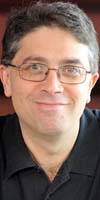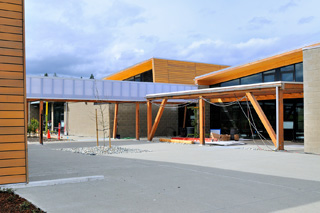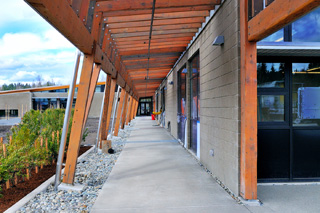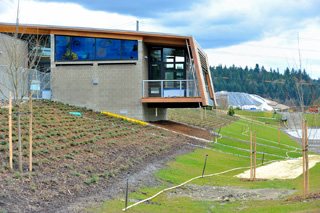|
Subscribe / Renew |
|
|
Contact Us |
|
| ► Subscribe to our Free Weekly Newsletter | |
| home | Welcome, sign in or click here to subscribe. | login |
Construction
| |
 |
July 7, 2011
A place for hands-on environmental education
Mithun

Cryan
|
During King County’s site selection process for the new Brightwater wastewater treatment facility, one of the candidates was a collection of properties in varying condition. The site had gravel lots with rusting hulks of cars, a series of buildings in differing states of disrepair, a landscaping business storage lot and recent development that hosted a stormwater system that fed a degraded salmon spawning area.
With Brightwater’s mission to protect water quality and more broadly, Puget Sound’s ecosystem, this property represented a great opportunity.
Working together, the county and design team analyzed the 114 acres and organized it into a series of special places, each with a unique purpose. The first 40 acres were the treatment plant buildings, tucked into the sloping hillside, taking advantage of gravity for efficient plant operations.
Another 40 acres in the north — the old landscaping storage lot — was restored to forest while a series of previously piped streams were exposed with natural pools and eddies, tree roots and shady cover. This created an enhanced salmon habitat that connects back to Little Bear Creek.
The remaining space along state Route 9 was shaped into a public park that uses topography and trees to create attractive user experiences and buffer views of the treatment facility. It also has wetland areas that treat runoff from pavement and buildings, and paths that host educational programs that explain the features of the site.
Brightwater Center
Brightwater’s environmental education and community center was located in the park as a focal point upon visitors’ arrival. As the public face of the project, the center will be available for school children, university classes, weddings and other events. It will teach visitors about the environmental work of Brightwater, as well as how to integrate these lessons into their daily lives.
Mithun worked with engineers and operators, ecologists and biologists, landscape architects and safety officers during the design of the treatment plant. For the center, King County expanded the design team by gathering a group of educators from local school districts to provide guidance on the building design and programs.
Over the years of design and construction, these teachers have stayed engaged in the project, securing funding from the state for programs, and creating alliances with universities and other schools for the use of the building once it opens.
The teachers formed a nonprofit — Friends of the Hidden River — to support the mission of the center, and assist in the design of a facility for testing alternative energy systems using waste methane from the adjacent treatment plant.
The center is targeted for LEED platinum certification, the highest level obtainable. It is important that the center educates through programs and exhibits as well as through building design.
During their visit to Brightwater, students will be given the opportunity to learn about wastewater treatment with both built and natural systems. They will be able to see how water is restored after it has been flushed down the toilet or swirled down the kitchen drain, as well as take samples of water from some of the natural systems on site and see how treatment works in the natural environment.
The center has been split into two wings to provide a variety of learning spaces: one as a large community space and exhibit hall; and the other focused on laboratory-based education.
Saving energy, water
Through the use of innovative systems and simple practices, energy use at the center has been reduced to levels far lower than required by the state energy code. The building was studied to see how much lighting could be provided without turning on the lights and how air conditioning could be eliminated by the use of concrete floors and walls and natural ventilation.
The center uses the treatment plant’s waste methane collected during the creation of fertilizer out of solid material to heat water for radiant floors and water use. The hot water loop is shut down in the summer and solar power is used for hot water at the sinks. In addition, photovoltaic panels were installed on the exterior walkway to provide additional electricity for computers and equipment.
The result is a facility that is completely reliant on sustainable energy sources for all space and water heating, uses minimal energy for fans and louvers to cool the space, and minimizes the use of electricity for lighting and other needs.
The project also restored site water function to its pre-development state, when the site was forested. This was met through various strategies. Water use has been reduced by low-flow fixtures and toilets flushed with reclaimed water from the plant, which will then return to the plant for treatment.
Reclaimed water is also used for irrigation and as the source for an art piece that displays the water at the entrance from state Route 9.
From the reclaimed wood beams around the center’s walkways to public art depicting the cycle of water as we borrow it and return it to nature — there are reminders of how we can connect built and natural environments for mutual benefit. The center is built to last for 100 years, educating generations of visitors about how to make these very connections.
Come experience Brightwater Center and see how it can connect to you.
Sean Cryan, LEED AP, is an associate principal at Mithun. With over 25 years of experience, he has spent the last 10 years working on the Brightwater treatment facility and environmental education and community center, from initial programming through final construction administration.
Other Stories:
- Brightwater design weds form and function
- Public process helped make Brightwater a reality
- Crews worked quickly to install marine outfall
- Designed to be a good neighbor
- A look around Brightwater





